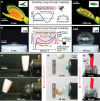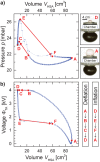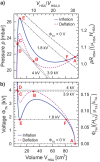A Lesson from Plants: High-Speed Soft Robotic Actuators
- PMID: 32154089
- PMCID: PMC7055565
- DOI: 10.1002/advs.201903391
A Lesson from Plants: High-Speed Soft Robotic Actuators
Abstract
Rapid energy-efficient movements are one of nature's greatest developments. Mechanisms like snap-buckling allow plants like the Venus flytrap to close the terminal lobes of their leaves at barely perceptible speed. Here, a soft balloon actuator is presented, which is inspired by such mechanical instabilities and creates safe, giant, and fast deformations. The basic design comprises two inflated elastomer membranes pneumatically coupled by a pressurized chamber of suitable volume. The high-speed actuation of a rubber balloon in a state close to the verge of mechanical instability is remotely triggered by a voltage-controlled dielectric elastomer membrane. This method spatially separates electrically active and passive parts, and thereby averts electrical breakdown resulting from the drastic thinning of an electroactive membrane during large expansion. Bistable operation with small and large volumes of the rubber balloon is demonstrated, achieving large volume changes of 1398% and a high-speed area change rate of 2600 cm2 s-1. The presented combination of fast response time with large deformation and safe handling are central aspects for a new generation of soft bio-inspired robots and can help pave the way for applications ranging from haptic displays to soft grippers and high-speed sorting machines.
Keywords: bioinspired dielectric elastomer actuators; coupled dielectric elastomer balloons; snap‐buckling; snap‐through instabilities; soft robotics for high‐speed actuation.
© 2020 The Authors. Published by WILEY‐VCH Verlag GmbH & Co. KGaA, Weinheim.
Conflict of interest statement
The authors declare no conflict of interest.
Figures




References
-
- Shepherd R. F., Stokes A. A., Freake J., Barber J., Snyder P. W., Mazzeo A. D., Cademartiri L., Morin S. A., Whitesides G. M., Angew. Chem., Int. Ed. 2013, 52, 2892. - PubMed
-
- Raibert M., Blankespoor K., Nelson G., Playter R., IFAC Proc. Vol. 2008, 41, 10822.
-
- Brown E., Rodenberg N., Amend J., Mozeika A., Steltz E., Zakin M. R., Lipson H., Jaeger H. M., Proc. Natl. Acad. Sci. USA 2010, 107, 18809.
-
- Nagase J.‐Y., Saga N., Satoh T., Suzumori K., J. Intell. Mater. Syst. Struct. 2012, 23, 345.
LinkOut - more resources
Full Text Sources
